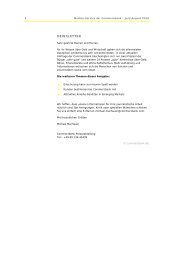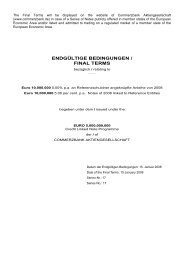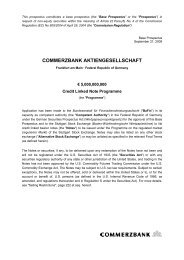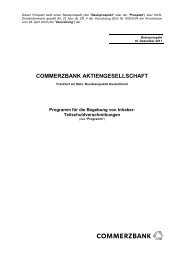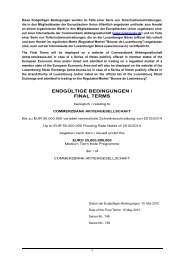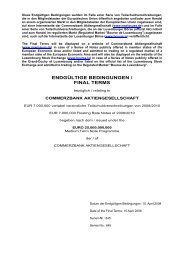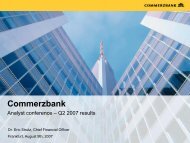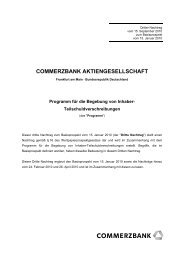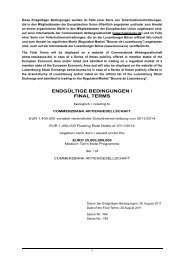COMMERZBANK AKTIENGESELLSCHAFT
COMMERZBANK AKTIENGESELLSCHAFT
COMMERZBANK AKTIENGESELLSCHAFT
You also want an ePaper? Increase the reach of your titles
YUMPU automatically turns print PDFs into web optimized ePapers that Google loves.
Group Financial Statements<br />
282<br />
226 Commerzbank Annual Report 2011<br />
(18) Investment properties<br />
Investment properties are defined as land and buildings held for<br />
the purpose of earning rental income or because they are<br />
expected to increase in value. Commerzbank Group also reports<br />
properties acquired as a result of the realisation of collateral in<br />
this category.<br />
Investment properties are valued at cost including directly<br />
attributable transaction costs on initial recognition in<br />
accordance with IAS 40. The fair value model is used for the<br />
subsequent valuation of investment property. Fair value is<br />
normally determined on the basis of annual valuations<br />
conducted by internal experts and on prices currently obtainable<br />
in the market. Properties used for commercial purposes are<br />
usually valued based on capitalised income; individual<br />
residential buildings are generally valued using the cost or sales<br />
comparison approach. Gains and losses arising from changes in<br />
fair value are shown under other net income in the income<br />
statement for the period.<br />
Current income and expenses are recognised in net interest<br />
income.<br />
(19) Non-current assets and disposal groups held for sale<br />
Non-current assets and disposal groups that can be sold in their<br />
current condition and if theire sale is highly probable must be<br />
classified as held for sale. These assets must be valued at fair<br />
value less costs to sell in cases where this is lower than book<br />
value. However, for interest-bearing and non-interest-bearing<br />
financial instruments and investment property the only<br />
accounting change is the reclassification to the relevant balance<br />
sheet items in accordance with IFRS 5. They continue to be<br />
measured in accordance with IAS 39 or IAS 40.<br />
If impairments are established as a result of measurement in<br />
accordance with IFRS 5, these are recognised in profit or loss,<br />
usually under net investment income for disposal groups and<br />
other net income for non-current assets. Any subsequent writeup<br />
is limited to the total of impairments previously recognised.<br />
After the assets have been sold, the gains or losses on<br />
disposal are recognised in other net income for non-current<br />
assets and usually in net investment income for disposal groups.<br />
(20) Liabilities<br />
If they are not held for trading purposes, financial liabilities are<br />
carried at amortised cost. The derivatives embedded in liabilities<br />
are separated from their host debt instrument where this is<br />
required, measured at fair value and recognised under either<br />
trading assets or trading liabilities. In micro fair value hedge<br />
accounting, hedged liabilities are adjusted for the change in fair<br />
value attributable to the hedged risk. In portfolio fair value<br />
hedge accounting the changes in fair value are reported under<br />
liabilities as value adjustments for portfolio fair value hedges.<br />
Liabilities for which the fair value option is used are recognised<br />
at their fair value.<br />
(21) Negative fair values of derivative hedging<br />
instruments<br />
This item shows derivative financial instruments that are used<br />
for hedging purposes and qualify for hedge accounting if they<br />
have a negative fair value. The hedging instruments are<br />
measured at fair value.<br />
(22) Trading liabilities<br />
Derivative financial instruments which are not used as hedging<br />
instruments in hedge accounting, lending commitments in the<br />
trading book which have a negative fair value are reported under<br />
trading liabilities. We also report own issues in the trading book<br />
and delivery obligations from short sales of securities in this<br />
item. Trading liabilities are measured at fair value through profit<br />
or loss.<br />
(23) Provisions<br />
A provision must be shown if on the balance sheet date, as the<br />
result of an event in the past, a current legal or factual obligation<br />
has arisen, an outflow of resources to meet this obligation is<br />
likely and it is possible to make a reliable estimate of the amount<br />
of this obligation. Accordingly we make provisions for liabilities<br />
of an uncertain amount to third parties and anticipated losses<br />
arising from pending transactions in the amount of the claims<br />
expected.



